Analysis of Key Audit Matters in the Banking Sector
VerifiedAdded on 2022/11/23
|16
|3249
|1
Report
AI Summary
This report provides a comprehensive analysis and evaluation of key audit matters (KAM) within the banking industry, focusing on the implications of the new auditing standard ISA 701. The paper begins by defining KAMs and outlining the responsibilities of auditors and those charged with governance in their identification and communication. It then examines the factors influencing the inclusion of KAMs in audit reports, emphasizing the need for clear and concise reporting. A significant portion of the report is dedicated to the case of Lehman Brothers, detailing the company's fraudulent financial practices, the role of its auditors, and the subsequent regulatory changes. The analysis extends to specific KAMs in the banking sector, such as loan impairment, value measurement of derivatives, goodwill, revenue recognition, and going concern, providing detailed explanations of how these matters are addressed in audit reports and the procedures followed. The report concludes by emphasizing the importance of KAMs in enhancing transparency and investor confidence in the banking industry. The report also includes key audit matters arising from the banking industry in the following six banks that are listed in the ASX: ABC, ASX limited, ANZ Banking Group Limited, AMP, Danske, and APA group and how they were addressed.
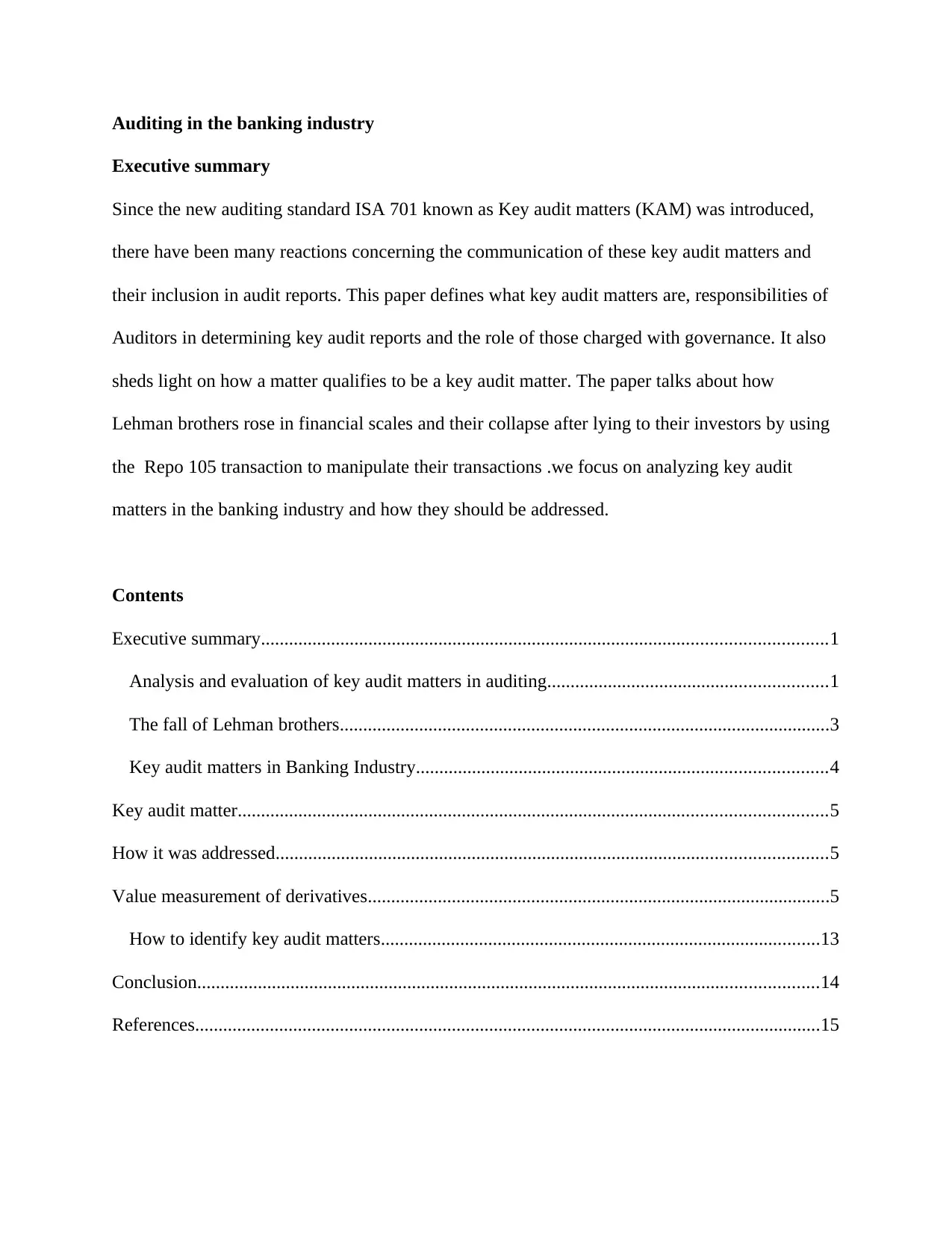
Auditing in the banking industry
Executive summary
Since the new auditing standard ISA 701 known as Key audit matters (KAM) was introduced,
there have been many reactions concerning the communication of these key audit matters and
their inclusion in audit reports. This paper defines what key audit matters are, responsibilities of
Auditors in determining key audit reports and the role of those charged with governance. It also
sheds light on how a matter qualifies to be a key audit matter. The paper talks about how
Lehman brothers rose in financial scales and their collapse after lying to their investors by using
the Repo 105 transaction to manipulate their transactions .we focus on analyzing key audit
matters in the banking industry and how they should be addressed.
Contents
Executive summary.........................................................................................................................1
Analysis and evaluation of key audit matters in auditing............................................................1
The fall of Lehman brothers.........................................................................................................3
Key audit matters in Banking Industry........................................................................................4
Key audit matter..............................................................................................................................5
How it was addressed......................................................................................................................5
Value measurement of derivatives...................................................................................................5
How to identify key audit matters..............................................................................................13
Conclusion.....................................................................................................................................14
References......................................................................................................................................15
Executive summary
Since the new auditing standard ISA 701 known as Key audit matters (KAM) was introduced,
there have been many reactions concerning the communication of these key audit matters and
their inclusion in audit reports. This paper defines what key audit matters are, responsibilities of
Auditors in determining key audit reports and the role of those charged with governance. It also
sheds light on how a matter qualifies to be a key audit matter. The paper talks about how
Lehman brothers rose in financial scales and their collapse after lying to their investors by using
the Repo 105 transaction to manipulate their transactions .we focus on analyzing key audit
matters in the banking industry and how they should be addressed.
Contents
Executive summary.........................................................................................................................1
Analysis and evaluation of key audit matters in auditing............................................................1
The fall of Lehman brothers.........................................................................................................3
Key audit matters in Banking Industry........................................................................................4
Key audit matter..............................................................................................................................5
How it was addressed......................................................................................................................5
Value measurement of derivatives...................................................................................................5
How to identify key audit matters..............................................................................................13
Conclusion.....................................................................................................................................14
References......................................................................................................................................15
Paraphrase This Document
Need a fresh take? Get an instant paraphrase of this document with our AI Paraphraser

Analysis and evaluation of key audit matters in auditing
Key audit matters (KAM) are issues communicated by those charged with governance, which is
considered of most significance in the auditing according to the judgment of an auditor
professionally.
Those charged with governance – these are people in the organization who have a role in
controlling the process of reporting about finances.
With the introduction of the new international audit standard ISA 701, it is a must for KAM to be
included in audits of all financial statements of listed firms. This regulation applies to all Sacco's,
insurance regulated firms and all companies that are governed by the capital market authority. It
doesn't matter whether the company is listed or non-listed.
According to Segal (2017) those charged with governance must receive communication from the
auditor concerning his roles, which relate to an audit of financial statements. The plan of how he
plans to carry out his audit, the identified significant risks, his view regarding the accounting
policies of the organization, financial statement disclosures and financial estimates, as well as the
obstacles, encountered while obtaining information among others.
For an auditor to confirm issues as key audit matters in the audit report, he must make sure these
issues have been communicated with those charged with governance. He must also put in
consideration matters that require the auditor’s scrutiny while compiling the report. For a matter
to qualify as KAM, the auditor must determine which matters we considered as most significant
and lastly, he must seek permission to look into sensitive matters (Jermakowicz, Epstein, and
Ramamoorti, 2018)
Key audit matters (KAM) are issues communicated by those charged with governance, which is
considered of most significance in the auditing according to the judgment of an auditor
professionally.
Those charged with governance – these are people in the organization who have a role in
controlling the process of reporting about finances.
With the introduction of the new international audit standard ISA 701, it is a must for KAM to be
included in audits of all financial statements of listed firms. This regulation applies to all Sacco's,
insurance regulated firms and all companies that are governed by the capital market authority. It
doesn't matter whether the company is listed or non-listed.
According to Segal (2017) those charged with governance must receive communication from the
auditor concerning his roles, which relate to an audit of financial statements. The plan of how he
plans to carry out his audit, the identified significant risks, his view regarding the accounting
policies of the organization, financial statement disclosures and financial estimates, as well as the
obstacles, encountered while obtaining information among others.
For an auditor to confirm issues as key audit matters in the audit report, he must make sure these
issues have been communicated with those charged with governance. He must also put in
consideration matters that require the auditor’s scrutiny while compiling the report. For a matter
to qualify as KAM, the auditor must determine which matters we considered as most significant
and lastly, he must seek permission to look into sensitive matters (Jermakowicz, Epstein, and
Ramamoorti, 2018)
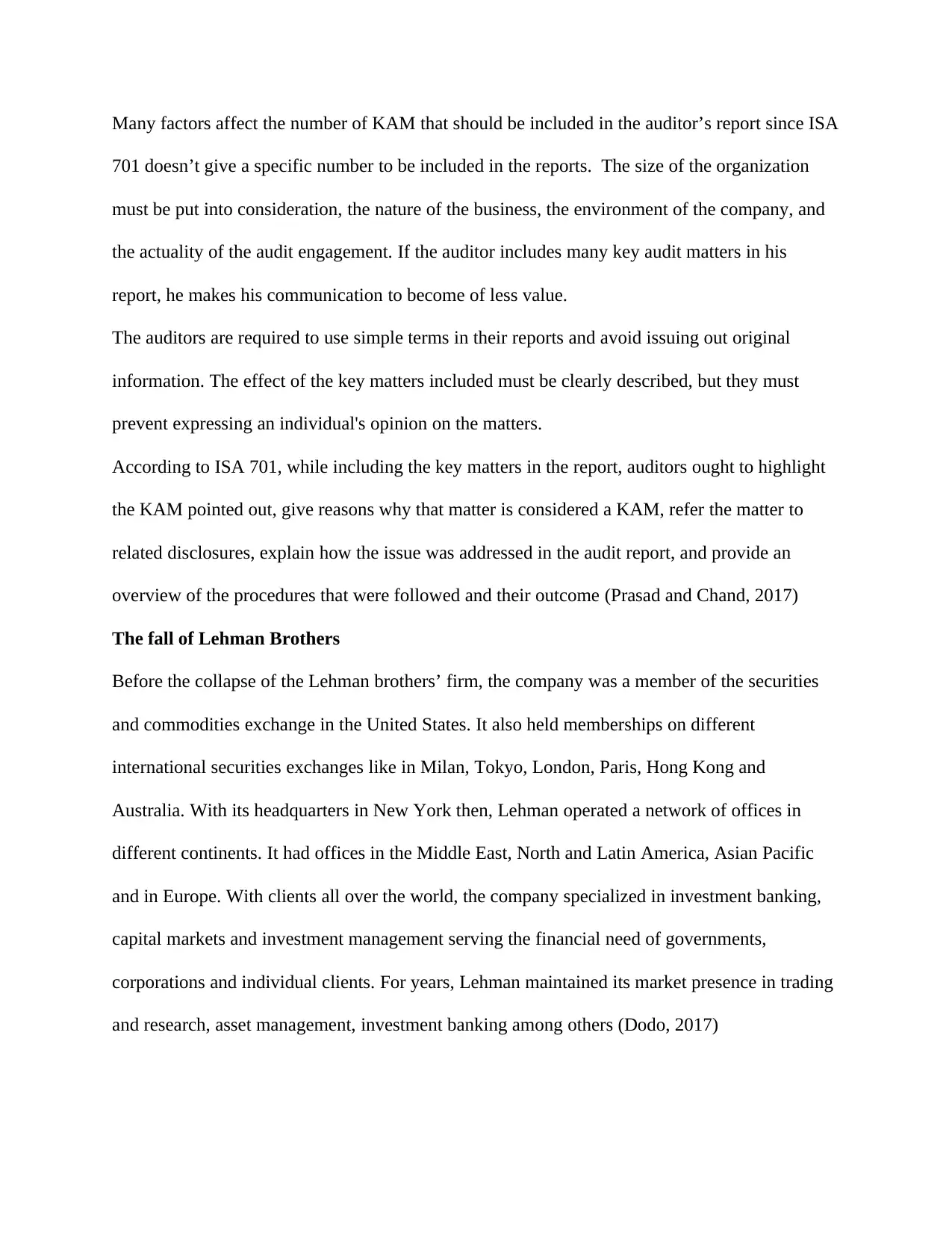
Many factors affect the number of KAM that should be included in the auditor’s report since ISA
701 doesn’t give a specific number to be included in the reports. The size of the organization
must be put into consideration, the nature of the business, the environment of the company, and
the actuality of the audit engagement. If the auditor includes many key audit matters in his
report, he makes his communication to become of less value.
The auditors are required to use simple terms in their reports and avoid issuing out original
information. The effect of the key matters included must be clearly described, but they must
prevent expressing an individual's opinion on the matters.
According to ISA 701, while including the key matters in the report, auditors ought to highlight
the KAM pointed out, give reasons why that matter is considered a KAM, refer the matter to
related disclosures, explain how the issue was addressed in the audit report, and provide an
overview of the procedures that were followed and their outcome (Prasad and Chand, 2017)
The fall of Lehman Brothers
Before the collapse of the Lehman brothers’ firm, the company was a member of the securities
and commodities exchange in the United States. It also held memberships on different
international securities exchanges like in Milan, Tokyo, London, Paris, Hong Kong and
Australia. With its headquarters in New York then, Lehman operated a network of offices in
different continents. It had offices in the Middle East, North and Latin America, Asian Pacific
and in Europe. With clients all over the world, the company specialized in investment banking,
capital markets and investment management serving the financial need of governments,
corporations and individual clients. For years, Lehman maintained its market presence in trading
and research, asset management, investment banking among others (Dodo, 2017)
701 doesn’t give a specific number to be included in the reports. The size of the organization
must be put into consideration, the nature of the business, the environment of the company, and
the actuality of the audit engagement. If the auditor includes many key audit matters in his
report, he makes his communication to become of less value.
The auditors are required to use simple terms in their reports and avoid issuing out original
information. The effect of the key matters included must be clearly described, but they must
prevent expressing an individual's opinion on the matters.
According to ISA 701, while including the key matters in the report, auditors ought to highlight
the KAM pointed out, give reasons why that matter is considered a KAM, refer the matter to
related disclosures, explain how the issue was addressed in the audit report, and provide an
overview of the procedures that were followed and their outcome (Prasad and Chand, 2017)
The fall of Lehman Brothers
Before the collapse of the Lehman brothers’ firm, the company was a member of the securities
and commodities exchange in the United States. It also held memberships on different
international securities exchanges like in Milan, Tokyo, London, Paris, Hong Kong and
Australia. With its headquarters in New York then, Lehman operated a network of offices in
different continents. It had offices in the Middle East, North and Latin America, Asian Pacific
and in Europe. With clients all over the world, the company specialized in investment banking,
capital markets and investment management serving the financial need of governments,
corporations and individual clients. For years, Lehman maintained its market presence in trading
and research, asset management, investment banking among others (Dodo, 2017)
⊘ This is a preview!⊘
Do you want full access?
Subscribe today to unlock all pages.

Trusted by 1+ million students worldwide
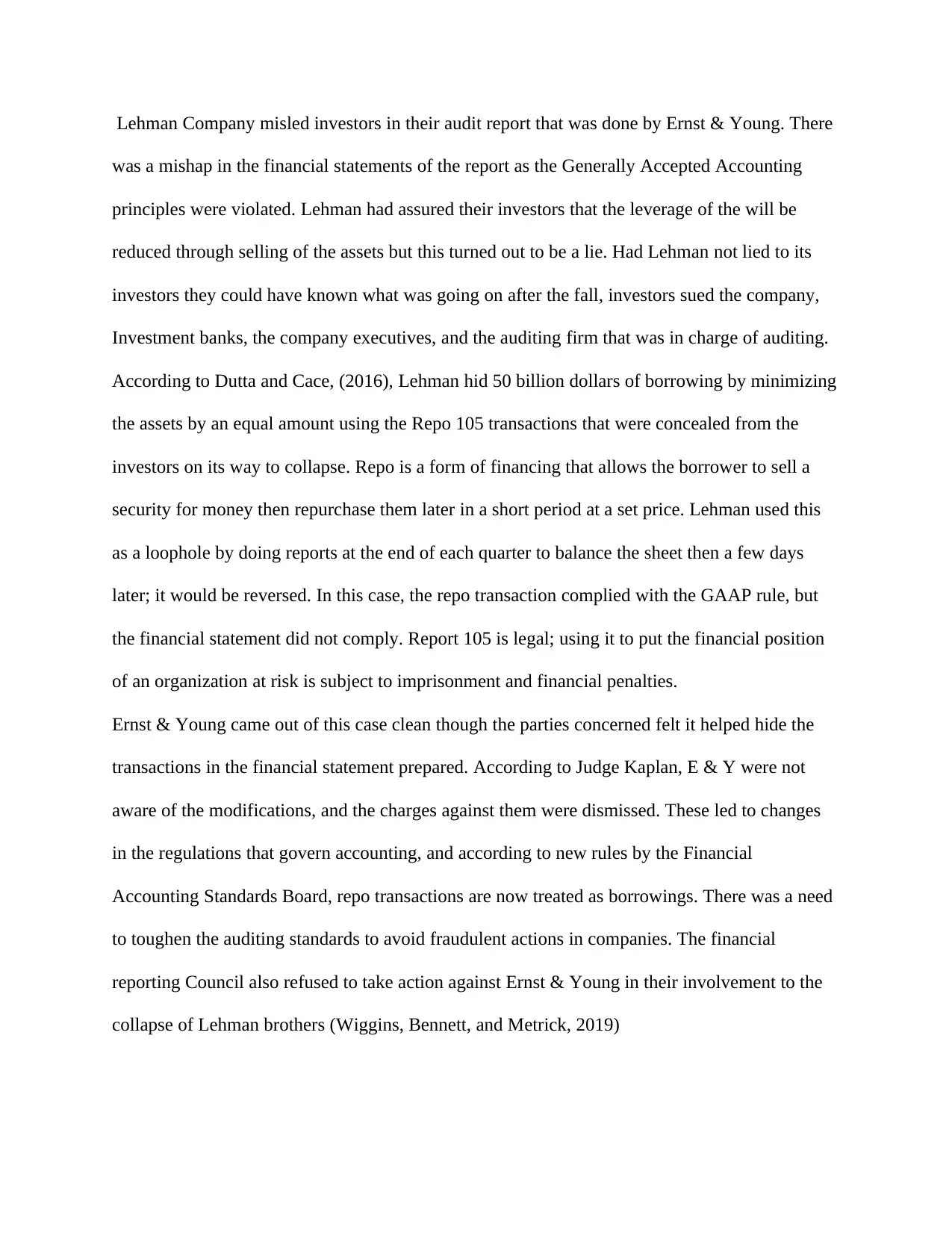
Lehman Company misled investors in their audit report that was done by Ernst & Young. There
was a mishap in the financial statements of the report as the Generally Accepted Accounting
principles were violated. Lehman had assured their investors that the leverage of the will be
reduced through selling of the assets but this turned out to be a lie. Had Lehman not lied to its
investors they could have known what was going on after the fall, investors sued the company,
Investment banks, the company executives, and the auditing firm that was in charge of auditing.
According to Dutta and Cace, (2016), Lehman hid 50 billion dollars of borrowing by minimizing
the assets by an equal amount using the Repo 105 transactions that were concealed from the
investors on its way to collapse. Repo is a form of financing that allows the borrower to sell a
security for money then repurchase them later in a short period at a set price. Lehman used this
as a loophole by doing reports at the end of each quarter to balance the sheet then a few days
later; it would be reversed. In this case, the repo transaction complied with the GAAP rule, but
the financial statement did not comply. Report 105 is legal; using it to put the financial position
of an organization at risk is subject to imprisonment and financial penalties.
Ernst & Young came out of this case clean though the parties concerned felt it helped hide the
transactions in the financial statement prepared. According to Judge Kaplan, E & Y were not
aware of the modifications, and the charges against them were dismissed. These led to changes
in the regulations that govern accounting, and according to new rules by the Financial
Accounting Standards Board, repo transactions are now treated as borrowings. There was a need
to toughen the auditing standards to avoid fraudulent actions in companies. The financial
reporting Council also refused to take action against Ernst & Young in their involvement to the
collapse of Lehman brothers (Wiggins, Bennett, and Metrick, 2019)
was a mishap in the financial statements of the report as the Generally Accepted Accounting
principles were violated. Lehman had assured their investors that the leverage of the will be
reduced through selling of the assets but this turned out to be a lie. Had Lehman not lied to its
investors they could have known what was going on after the fall, investors sued the company,
Investment banks, the company executives, and the auditing firm that was in charge of auditing.
According to Dutta and Cace, (2016), Lehman hid 50 billion dollars of borrowing by minimizing
the assets by an equal amount using the Repo 105 transactions that were concealed from the
investors on its way to collapse. Repo is a form of financing that allows the borrower to sell a
security for money then repurchase them later in a short period at a set price. Lehman used this
as a loophole by doing reports at the end of each quarter to balance the sheet then a few days
later; it would be reversed. In this case, the repo transaction complied with the GAAP rule, but
the financial statement did not comply. Report 105 is legal; using it to put the financial position
of an organization at risk is subject to imprisonment and financial penalties.
Ernst & Young came out of this case clean though the parties concerned felt it helped hide the
transactions in the financial statement prepared. According to Judge Kaplan, E & Y were not
aware of the modifications, and the charges against them were dismissed. These led to changes
in the regulations that govern accounting, and according to new rules by the Financial
Accounting Standards Board, repo transactions are now treated as borrowings. There was a need
to toughen the auditing standards to avoid fraudulent actions in companies. The financial
reporting Council also refused to take action against Ernst & Young in their involvement to the
collapse of Lehman brothers (Wiggins, Bennett, and Metrick, 2019)
Paraphrase This Document
Need a fresh take? Get an instant paraphrase of this document with our AI Paraphraser

The failure of Lehman Brothers resulted in policy makers questioning the efficiency of auditors
prompting them to come up with a law that will make auditors improve their work.
Key audit matters in Banking Industry
Matters in the financial statements that were of most significance in the auditor’s professional
judgment are those referred to as Key Audit Matters. The matters are chosen from a list of
matters conveyed by those charged with governance. Examples of KAM’s in the banking
industry include; Debt instruments, Employee entitlements ,Related party transactions, Share-
based payments, Contingent Liabilities, Equity ,Taxation, Information technology, Receivables
Provisions, Insurance liabilities, Investments Financial instruments ,Going concern, Biological
assets Associates & joint ventures Inventory Impairment, Research & development costs,
Acquisitions, disposals and Revenue recognition of Property, plant & equipment (Danescu, and
Spatacean, 2018)
Below are key audit matters arising from the banking industry in the following six banks that are
listed in the ASX: ABC, ASX limited, ANZ Banking Group Limited, AMP, Danske, and APA
group and how they were addressed.
prompting them to come up with a law that will make auditors improve their work.
Key audit matters in Banking Industry
Matters in the financial statements that were of most significance in the auditor’s professional
judgment are those referred to as Key Audit Matters. The matters are chosen from a list of
matters conveyed by those charged with governance. Examples of KAM’s in the banking
industry include; Debt instruments, Employee entitlements ,Related party transactions, Share-
based payments, Contingent Liabilities, Equity ,Taxation, Information technology, Receivables
Provisions, Insurance liabilities, Investments Financial instruments ,Going concern, Biological
assets Associates & joint ventures Inventory Impairment, Research & development costs,
Acquisitions, disposals and Revenue recognition of Property, plant & equipment (Danescu, and
Spatacean, 2018)
Below are key audit matters arising from the banking industry in the following six banks that are
listed in the ASX: ABC, ASX limited, ANZ Banking Group Limited, AMP, Danske, and APA
group and how they were addressed.

Key audit matter How it was addressed
Value measurement of derivatives
management judgment is required to choose
which model to use to measure derivatives
amount
Value measurement of derivatives.
Adjustments and changes in the model used
has a material impact on measurements of
Looking at the valuation performed by
management.
Examining the methodology used.
Evaluating assumptions made.
Key audit matter How it was addressed
Loan impairment
It was found to be a KAM because of the
massive amount of loans in the balance sheet.
The methods and the assumptions used
determines the measure of the impairment.
Evaluating assumptions and methods used.
Examining the impairment charges.
.
Using valuation experts to get audit evidence.
Using industry knowledge to challenge
methodologies used.
Evaluating the consistency of approach to
obtain evidence of management judgments.
Carrying out a risk-based test of loans to
identify impairment loans.
Value measurement of derivatives
management judgment is required to choose
which model to use to measure derivatives
amount
Value measurement of derivatives.
Adjustments and changes in the model used
has a material impact on measurements of
Looking at the valuation performed by
management.
Examining the methodology used.
Evaluating assumptions made.
Key audit matter How it was addressed
Loan impairment
It was found to be a KAM because of the
massive amount of loans in the balance sheet.
The methods and the assumptions used
determines the measure of the impairment.
Evaluating assumptions and methods used.
Examining the impairment charges.
.
Using valuation experts to get audit evidence.
Using industry knowledge to challenge
methodologies used.
Evaluating the consistency of approach to
obtain evidence of management judgments.
Carrying out a risk-based test of loans to
identify impairment loans.
⊘ This is a preview!⊘
Do you want full access?
Subscribe today to unlock all pages.

Trusted by 1+ million students worldwide

derivatives and loss or profit.
Management judgment on this KAM requires
a valuation for the product, model input used
and adjustments to markets.
Examining key changes in assumptions
against historical data and standards of the
industry.
Using independent data to re-calculating
carrying amounts found in the balance sheet.
·
Key audit matter How it was addressed
Goodwill
The organization is supposed to test annually the
amount of good will impairment
The yearly impairment test was important to the
audit because of the complexity of the assessment
process as it is based on assumptions which are
affected by future economic conditions and
markets in foreign countries.
Checking the management controls that relate.
Calibration and development of the model and
to determine that management’s decision of
making adjustments to the output of the mode
was not necessary to show the assumptions
that clients would use in the same
circumstances.
Management judgment on this KAM requires
a valuation for the product, model input used
and adjustments to markets.
Examining key changes in assumptions
against historical data and standards of the
industry.
Using independent data to re-calculating
carrying amounts found in the balance sheet.
·
Key audit matter How it was addressed
Goodwill
The organization is supposed to test annually the
amount of good will impairment
The yearly impairment test was important to the
audit because of the complexity of the assessment
process as it is based on assumptions which are
affected by future economic conditions and
markets in foreign countries.
Checking the management controls that relate.
Calibration and development of the model and
to determine that management’s decision of
making adjustments to the output of the mode
was not necessary to show the assumptions
that clients would use in the same
circumstances.
Paraphrase This Document
Need a fresh take? Get an instant paraphrase of this document with our AI Paraphraser

The audit procedure used was using an expert in
valuation to help evaluate the methodologies and
assumptions used especially those that relate to
the revenue growth forecasted.
The audit based on how adequate the group
disclosures on assumptions to which the result of
the impairment test is very sensitive.
Key Audit Matter How it as addressed
Revenue recognition in contracts
Revenue Recognition in Long-Term
Contracts.
The group’s revenue is affected by the terms and
conditions of long-term contracts because revenue
from these contracts always represent the total of
all the group revenue.
The revenue recognition of such contracts was
Testing the group controls to confirm the
terms and conditions of the agreement directly
clients.
Testing the entries by management that relate
to the revenue recognition.
According to the audit that was carried out,
here was no evidence of side agreements in
valuation to help evaluate the methodologies and
assumptions used especially those that relate to
the revenue growth forecasted.
The audit based on how adequate the group
disclosures on assumptions to which the result of
the impairment test is very sensitive.
Key Audit Matter How it as addressed
Revenue recognition in contracts
Revenue Recognition in Long-Term
Contracts.
The group’s revenue is affected by the terms and
conditions of long-term contracts because revenue
from these contracts always represent the total of
all the group revenue.
The revenue recognition of such contracts was
Testing the group controls to confirm the
terms and conditions of the agreement directly
clients.
Testing the entries by management that relate
to the revenue recognition.
According to the audit that was carried out,
here was no evidence of side agreements in

identified as a risk that requires special audit
because unrecorded side agreements may exist and
be concealed presenting a misstatement risk
because of fraud.
existence.
Key audit matter How it was addressed
Going concern
A Going concern was used to prepare all
financial statements.
It’s okay appropriate to use the basis of
accounting except when the management
want to cease operations or liquidate the
group.
Analyzing going concern to find any
uncertainties that may cause the group to stop
using the going concern.
Checking the financial statements to identify
material uncertainty.
because unrecorded side agreements may exist and
be concealed presenting a misstatement risk
because of fraud.
existence.
Key audit matter How it was addressed
Going concern
A Going concern was used to prepare all
financial statements.
It’s okay appropriate to use the basis of
accounting except when the management
want to cease operations or liquidate the
group.
Analyzing going concern to find any
uncertainties that may cause the group to stop
using the going concern.
Checking the financial statements to identify
material uncertainty.
⊘ This is a preview!⊘
Do you want full access?
Subscribe today to unlock all pages.

Trusted by 1+ million students worldwide
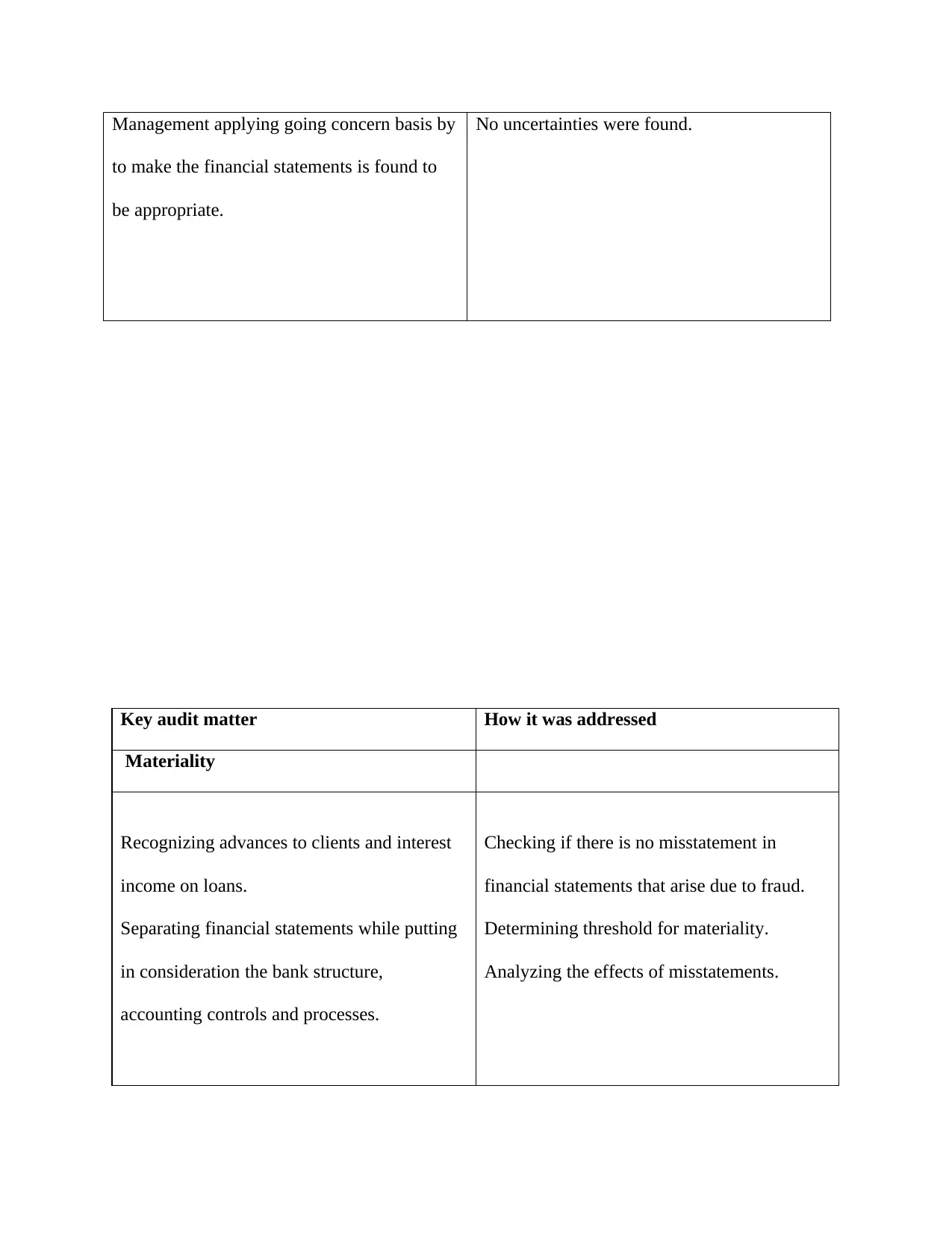
Management applying going concern basis by
to make the financial statements is found to
be appropriate.
No uncertainties were found.
Key audit matter How it was addressed
Materiality
Recognizing advances to clients and interest
income on loans.
Separating financial statements while putting
in consideration the bank structure,
accounting controls and processes.
Checking if there is no misstatement in
financial statements that arise due to fraud.
Determining threshold for materiality.
Analyzing the effects of misstatements.
to make the financial statements is found to
be appropriate.
No uncertainties were found.
Key audit matter How it was addressed
Materiality
Recognizing advances to clients and interest
income on loans.
Separating financial statements while putting
in consideration the bank structure,
accounting controls and processes.
Checking if there is no misstatement in
financial statements that arise due to fraud.
Determining threshold for materiality.
Analyzing the effects of misstatements.
Paraphrase This Document
Need a fresh take? Get an instant paraphrase of this document with our AI Paraphraser
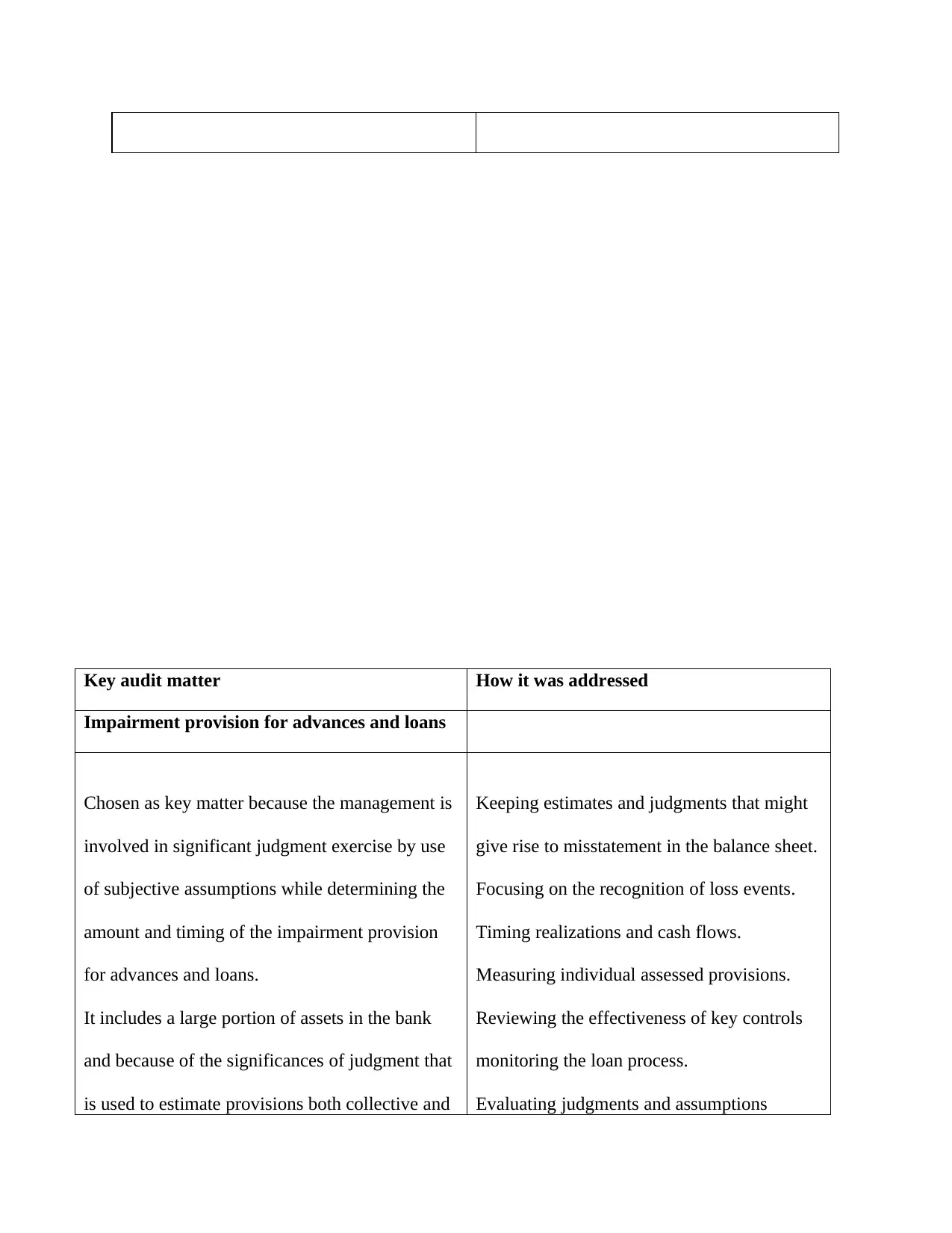
Key audit matter How it was addressed
Impairment provision for advances and loans
Chosen as key matter because the management is
involved in significant judgment exercise by use
of subjective assumptions while determining the
amount and timing of the impairment provision
for advances and loans.
It includes a large portion of assets in the bank
and because of the significances of judgment that
is used to estimate provisions both collective and
Keeping estimates and judgments that might
give rise to misstatement in the balance sheet.
Focusing on the recognition of loss events.
Timing realizations and cash flows.
Measuring individual assessed provisions.
Reviewing the effectiveness of key controls
monitoring the loan process.
Evaluating judgments and assumptions
Impairment provision for advances and loans
Chosen as key matter because the management is
involved in significant judgment exercise by use
of subjective assumptions while determining the
amount and timing of the impairment provision
for advances and loans.
It includes a large portion of assets in the bank
and because of the significances of judgment that
is used to estimate provisions both collective and
Keeping estimates and judgments that might
give rise to misstatement in the balance sheet.
Focusing on the recognition of loss events.
Timing realizations and cash flows.
Measuring individual assessed provisions.
Reviewing the effectiveness of key controls
monitoring the loan process.
Evaluating judgments and assumptions
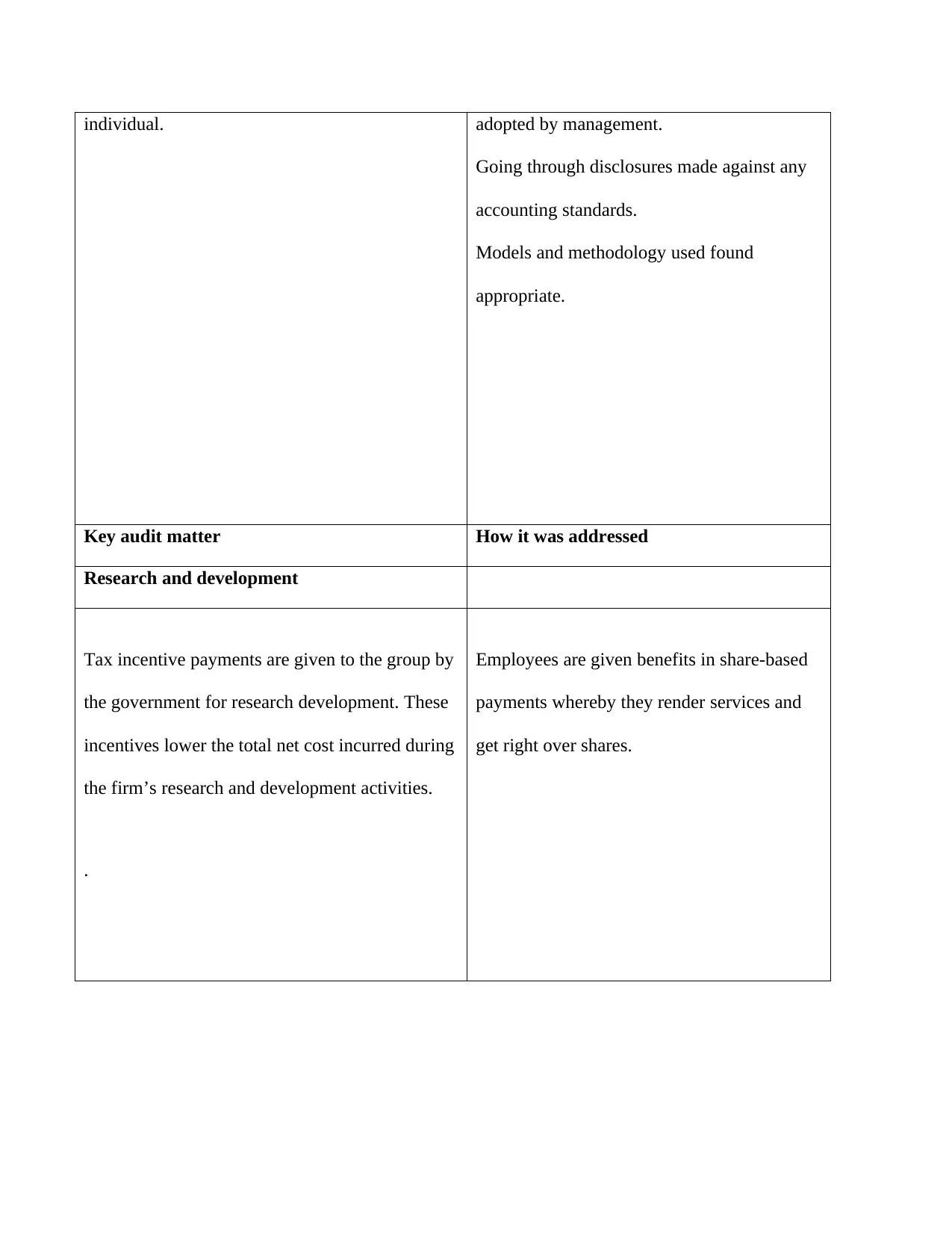
individual. adopted by management.
Going through disclosures made against any
accounting standards.
Models and methodology used found
appropriate.
Key audit matter How it was addressed
Research and development
Tax incentive payments are given to the group by
the government for research development. These
incentives lower the total net cost incurred during
the firm’s research and development activities.
.
Employees are given benefits in share-based
payments whereby they render services and
get right over shares.
Going through disclosures made against any
accounting standards.
Models and methodology used found
appropriate.
Key audit matter How it was addressed
Research and development
Tax incentive payments are given to the group by
the government for research development. These
incentives lower the total net cost incurred during
the firm’s research and development activities.
.
Employees are given benefits in share-based
payments whereby they render services and
get right over shares.
⊘ This is a preview!⊘
Do you want full access?
Subscribe today to unlock all pages.

Trusted by 1+ million students worldwide
1 out of 16
Related Documents
Your All-in-One AI-Powered Toolkit for Academic Success.
+13062052269
info@desklib.com
Available 24*7 on WhatsApp / Email
![[object Object]](/_next/static/media/star-bottom.7253800d.svg)
Unlock your academic potential
Copyright © 2020–2025 A2Z Services. All Rights Reserved. Developed and managed by ZUCOL.





